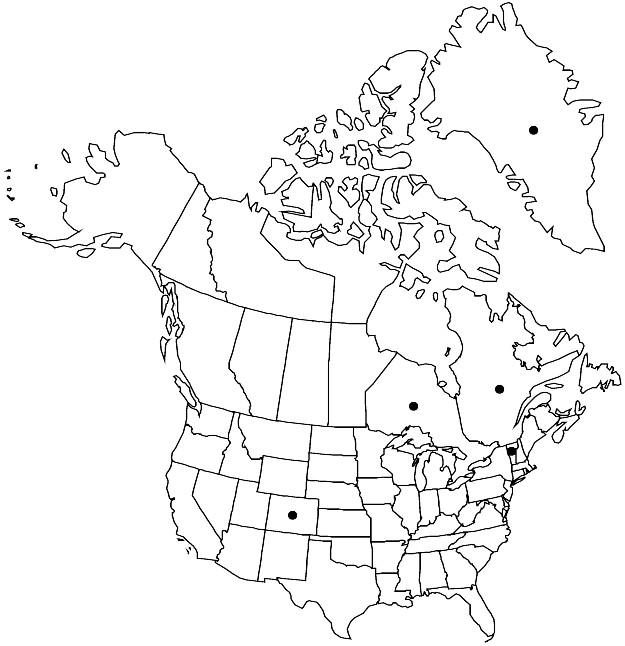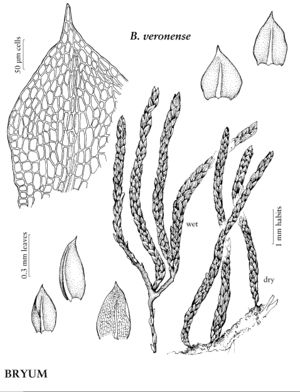Difference between revisions of "Bryum veronense"
Comment. Soc. Crittog. Ital. 2: 212. 1865.
FNA>Volume Importer |
imported>Volume Importer |
||
| (6 intermediate revisions by 2 users not shown) | |||
| Line 9: | Line 9: | ||
|special_status={{Treatment/ID/Special_status | |special_status={{Treatment/ID/Special_status | ||
|code=F | |code=F | ||
| − | |label= | + | |label=Illustrated |
}} | }} | ||
|basionyms= | |basionyms= | ||
| Line 26: | Line 26: | ||
|elevation=high elevations (1700 m) | |elevation=high elevations (1700 m) | ||
|distribution=Greenland;Ont.;Que.;Colo.;Vt.;Europe. | |distribution=Greenland;Ont.;Que.;Colo.;Vt.;Europe. | ||
| − | |discussion=<p>Bryum veronense was first collected from the Front Range of Colorado near Boulder by W. A. Weber and R. C. Wittmann, in soil filled crevices in sandstone. The plants agree well with named European material, although they are a dark olive green rather than the bright green of European material. Since then the species has been collected from Ontario, Quebec, and Vermont. This species is similar to B. calobryoides, but lacks the strongly julaceous stems, strongly concave leaves, and cucullate apices of that species.</p> | + | |discussion=<p><i>Bryum veronense</i> was first collected from the Front Range of Colorado near Boulder by W. A. Weber and R. C. Wittmann, in soil filled crevices in sandstone. The plants agree well with named European material, although they are a dark olive green rather than the bright green of European material. Since then the species has been collected from Ontario, Quebec, and Vermont. This species is similar to <i>B. calobryoides</i>, but lacks the strongly julaceous stems, strongly concave leaves, and cucullate apices of that species.</p> |
|tables= | |tables= | ||
|references= | |references= | ||
| Line 35: | Line 35: | ||
-->{{#Taxon: | -->{{#Taxon: | ||
name=Bryum veronense | name=Bryum veronense | ||
| − | |||
|authority=De Notaris | |authority=De Notaris | ||
|rank=species | |rank=species | ||
| Line 48: | Line 47: | ||
|publication title=Comment. Soc. Crittog. Ital. | |publication title=Comment. Soc. Crittog. Ital. | ||
|publication year=1865 | |publication year=1865 | ||
| − | |special status= | + | |special status=Illustrated |
| − | |source xml=https:// | + | |source xml=https://bitbucket.org/aafc-mbb/fna-data-curation/src/2e0870ddd59836b60bcf96646a41e87ea5a5943a/coarse_grained_fna_xml/V28/V28_201.xml |
|genus=Bryum | |genus=Bryum | ||
|species=Bryum veronense | |species=Bryum veronense | ||
Latest revision as of 21:34, 5 November 2020
Plants in dense mats, bright to dark green or olive green. Stems 0.4–1 cm, weakly julaceous to stringlike. Leaves erect when moist, ovate, weakly concave, 0.2–1 mm; base green; margins plane distally or rarely recurved proximally; apex acute, not cucullate, not hyaline; costa not reaching apex, apiculus absent or very short, 1 or 2 cells, hyaline; proximal laminal cells short-rectangular, at least in alar region, 12–18 µm wide, 2–3:1; distal cells hexagonal, (25–)30–55 × 10–16 µm, usually 3:1, walls thin to somewhat thickened, not distinctly incrassate. Specialized asexual reproduction absent. Sporophytes unknown.
Habitat: Damp to dry soil, soil filled crevices in sandstone
Elevation: high elevations (1700 m)
Distribution

Greenland, Ont., Que., Colo., Vt., Europe.
Discussion
Bryum veronense was first collected from the Front Range of Colorado near Boulder by W. A. Weber and R. C. Wittmann, in soil filled crevices in sandstone. The plants agree well with named European material, although they are a dark olive green rather than the bright green of European material. Since then the species has been collected from Ontario, Quebec, and Vermont. This species is similar to B. calobryoides, but lacks the strongly julaceous stems, strongly concave leaves, and cucullate apices of that species.
Selected References
None.
